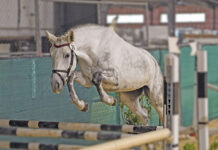Equitation on the flat is a chance for you to show the judge just how effectively you ride. The goal of the class is to use invisible aids to show off all three of your horse’s gaits, in both directions of the ring. Try these tips to impress them in your next hunt seat equitation on the flat class.

Equitation on the Flat – Rider Basics
The very basics of equitation on the flat require that you have a secure seat; you should have a straight line that runs through your ear, shoulder, hip and heel, no matter what gait you’re riding in.
Seat: You should sit in the saddle in an equitation class, feeling your saddle with your seat bones. You will use this deeper seat in all gaits unless asked to hand gallop. Don’t use a half-seat at the canter!
Legs: It can be tempting to pinch with your knee as you try to sit deeply at the canter, especially if your pony is uncomfortable to ride, but try your best to sink into your heels and put even contact all the way down your thigh and calf.
Pinched knees lead to a loose lower leg because where your knee is on the saddle acts as a pivot, swinging your lower leg back. This swinging leg may accidentally hit your pony, making him go even faster and making you grip even harder as you try to stay on with your muscle alone.
Hands: There should be a straight line from your elbows to your horse’s mouth; your hands should be held in front of horse’s withers. Your thumbs should be up and your fingers should be closed softly around the reins. Your hands should be far enough apart that an orange would fit between them.
Elbows: Your elbows are a hinge that absorb your horse’s movement as his head and neck rise and fall with his stride. Your goal is to softly follow your horse’s mouth, opening and closing your elbows as you rise with the trot and as your horse steps forward into the canter.
Equitation on the Flat – How Your Horse Should Move
When you’re in an equitation class, your horse should move forward, no matter what the judge is asking of you. It can be tempting to ask your horse to trot very slowly when you’re asked to sit the trot, but this doesn’t show off how well you can ride!
Ride your horse forward, like you’re squeezing a tube of toothpaste with your legs and catching it in the bridle with your hands. You want some contact with his face—this is not an under-saddle class where only the horse’s movement is judged—so you can easily ask for downward transitions and bend.
If the judge asks you to hand gallop, get out of your saddle and be light on your horse’s back as you nudge him forward to extend his stride.

In the Show Ring
It’s easy to get lost in the crowd in the show ring, so you’ll need to be very strategic in your riding to make sure you’re noticed by the judge in an equitation on the flat class. Here are some tips that will allow you to show off your awesome equitation:
- Use the quarter line in the ring, a few feet off the rail, when you ride directly in front of the judge. He has a hard time seeing all of you when you’re so close to him.
- Find your own space in the ring and don’t get caught up in the crowd. You could be blocked in and no one will be able to see your hard work!
- Feel your leads instead of looking down for them. You always want your eyes up on where you’re headed. This will also show the judge that you are an educated rider.
- Take your time when making transitions and wait until you have a clear path on the rail. It’s not worth blasting into a canter if you only have two strides before you run up on the pony in front of you.
- Don’t immediately start posting when you trot. Sit a few beats until you feel the proper diagonal, then begin posting. It’s better to get the correct diagonal on the first try than having to sit and change.
- Show off how well-trained your horse is by bending him in the corners to show that he’s light on your inside rein.
- If you pick up the wrong lead, canter when you’re supposed to trot or do anything else unexpected, fix your mistake quickly and effectively—don’t draw attention to yourself.
Remember to show your horse until the end of the class. When you are called to line up for the judge, stay together with the group to form an even, orderly line. Sit up straight, pay attention and keep your horse standing still and square.
Thanking your horse with a pat and praise as you leave the ring always shows good sportsmanship. If you win a ribbon, no matter what color, be sure to smile!
This article originally appeared in the November/December 2017 issue of Young Rider magazine. Click here to subscribe!






